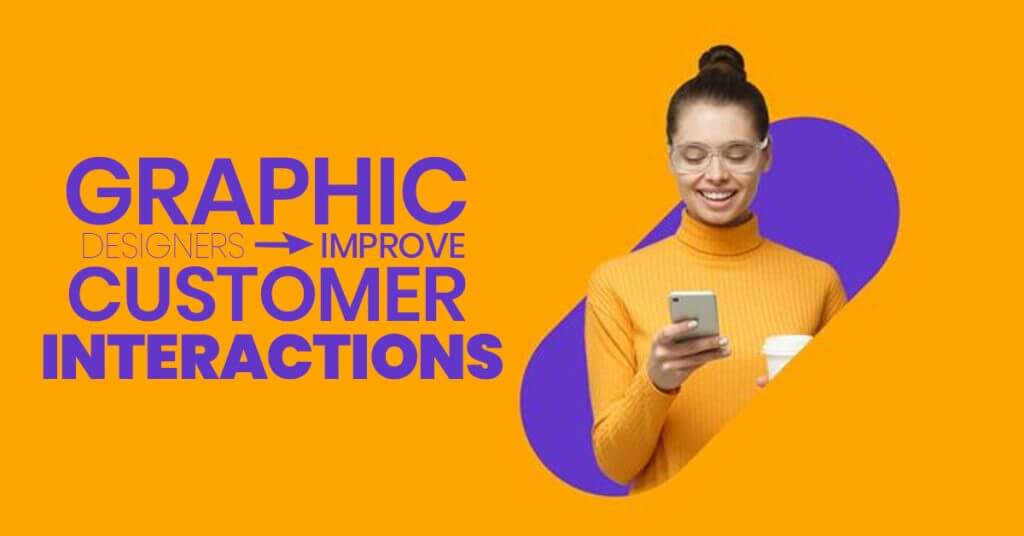In today’s visually-driven world, graphic designers play a vital role in shaping customer interactions with businesses. Their creative expertise goes beyond aesthetics, as they possess the power to enhance communication, build brand loyalty, and create memorable experiences.
In this article, we will explore the ways in which graphic designers improve customer interactions and how their skills contribute to successful business outcomes.
The Role of Graphic Designers:
The Visual Language of Communication
Visual communication is a universal language that transcends barriers and connects people on a deeper level. Graphic designers harness this language to communicate messages effectively, using imagery, color, typography, and layout. By understanding the target audience, graphic designers can create designs that resonate with customers, ensuring the message is conveyed clearly and compellingly.

Establishing Brand Identity and Recognition
A strong brand identity is crucial for businesses to differentiate themselves in a crowded marketplace. Graphic designers play a pivotal role in developing brand identities that reflect a company’s values, personality, and vision. Through the strategic use of design elements, such as logos, color schemes, and visual consistency across various touchpoints, graphic designers ensure that customers recognize and remember the brand, fostering a sense of trust and familiarity.
User-Friendly Interfaces and Experiences
In today’s digital landscape, user experience (UX) is a key differentiator for businesses. Graphic designers collaborate with UX designers and developers to create intuitive interfaces that enhance customer interactions. They focus on usability, ensuring that customers can navigate websites, apps, and digital platforms with ease. Through thoughtful design choices, such as intuitive navigation menus, clear call-to-action buttons, and visually appealing layouts, graphic designers contribute to seamless user experiences that keep customers engaged and satisfied.
Evoking Emotions and Building Connections
Emotions have a profound impact on customer behavior and decision-making. Graphic designers leverage their understanding of psychology and visual storytelling to evoke specific emotions through their designs. Whether it’s through captivating imagery, evocative color palettes, or well-crafted illustrations, graphic designers have the ability to create an emotional connection between customers and brands. By tapping into customers’ emotions, they foster brand loyalty, advocacy, and long-lasting relationships.
Enhancing Content Engagement
Compelling content is essential for capturing customers’ attention and keeping them engaged. Graphic designers collaborate with content creators to visually enhance articles, social media posts, infographics, and other forms of content. By incorporating relevant visuals, such as eye-catching illustrations, attention-grabbing headlines, and well-designed layouts, graphic designers optimize content for readability and visual appeal. These visual enhancements not only make the content more enjoyable to consume but also increase its shareability and virality on social media platforms.
Personalizing Customer Experiences
Personalization is a key trend in modern marketing, as customers seek tailored experiences. Graphic designers contribute to personalization efforts by creating customized visual assets, such as personalized emails, targeted advertisements, and personalized packaging. By infusing design with personal touches, such as personalized illustrations or tailored messages, graphic designers help businesses create memorable moments that resonate with customers on an individual level.

Graphic designers are more than just artists; they are strategic partners in shaping customer interactions. Through their expertise in visual communication, brand identity development, user experience design, emotional storytelling, content enhancement, and personalization, graphic designers elevate the customer experience and contribute to business success. By understanding the value they bring to customer interactions, businesses can harness the power of graphic design to build strong connections, foster loyalty, and create meaningful experiences that leave a lasting impression on customers.
Frequently Asked Questions(FAQ):
How can I get clients as a graphic designer?
To get clients as a graphic designer, consider the following strategies:
– Create an online portfolio showcasing your best work.
– Network with professionals in related fields, such as marketers or web developers.
– Utilize social media platforms to showcase your skills and reach out to potential clients.
– Offer pro bono work or discounted services to build your portfolio and gain exposure.
– Join freelance platforms or design communities where clients post design projects.
How do graphic designers work with clients?
Graphic designers typically follow these steps when working with clients:
– Understand the client’s goals, target audience, and project requirements.
– Conduct research to gather inspiration and insights.
– Present initial design concepts for client feedback and approval.
– Incorporate client feedback and make revisions as needed.
– Finalize the design and prepare necessary files for delivery.
– Maintain clear communication throughout the process to ensure client satisfaction.
How do you engage an audience in design?
To engage an audience in design, consider the following techniques:
– Understand the target audience and tailor the design to their preferences and needs.
– Use visually appealing and compelling imagery or illustrations.
– Employ strategic use of color, typography, and layout to create visual hierarchy and impact.
– Incorporate storytelling elements to evoke emotions and connect with the audience.
How do you interact with design clients?
When interacting with design clients, consider the following approaches:
– Active listening: Understand their goals, expectations, and project requirements.
– Clarify any doubts or questions to ensure a clear understanding of their needs.
– Provide regular updates on the project’s progress and seek feedback at key milestones.
– Be open to constructive criticism and willing to make revisions based on client feedback.
Related Articles:









